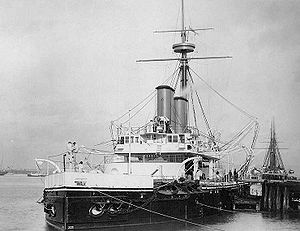HMS Dreadnought (1875)
 Bow view of Dreadnought, probably after 1894
| |
| Class overview | |
|---|---|
| Operators | |
| Preceded by | Devastation class |
| Completed | 1 |
| Scrapped | 1 |
| History | |
| Name | Dreadnought |
| Ordered | 1870 Naval Programme |
| Builder | Pembroke Dockyard |
| Way number | No. 2 |
| Laid down | 10 September 1870 |
| Launched | 8 March 1875 |
| Completed | 15 February 1879 |
| Commissioned | 1884 |
| Out of service | 1905 |
| Reclassified | As second-class battleship, 1900 |
| Fate | Sold for scrap, 14 July 1908 |
| General characteristics (as built) | |
| Type | Ironclad turret ship |
| Displacement | 10,886 long tons (11,061 t) |
| Length | 320 ft (97.5 m) (pp) *343 ft (105 m) (oa) |
| Beam | 63 ft 10 in (19.5 m) |
| Draught | 26 ft 6 in (8.1 m) |
| Installed power | 8,206 ihp (6,119 kW); 12 cylindrical boilers |
| Propulsion | 2 shafts; 2 compound-expansion steam engines |
| Speed | 14 knots (26 km/h; 16 mph) |
| Range | 5,700 nmi (10,600 km; 6,600 mi) @ 10 knots (19 km/h; 12 mph) |
| Complement | 369 |
| Armament | 4 × 12.5 in (320 mm) rifled muzzle-loading guns |
| Armour |
|
HMS Dreadnought was an
Background and design
Dreadnought was originally named Fury and was designed by the
The main changes were to increase the
Description
Dreadnought had a
The ship was the first large ironclad to have two 3-cylinder inverted vertical compound-expansion steam engines. These were built by Humphry & Tennant and each drove a single four-bladed, 20-foot (6.1 m) propeller. Dreadnought's engines were powered by a dozen cylindrical boilers with a working pressure of 60 psi (414 kPa; 4 kgf/cm2).[7] The engines were designed to produce a total of 8,000 indicated horsepower (6,000 kW) for a speed of 14 knots (26 km/h; 16 mph), this was 2,400 ihp (1,800 kW) more and 1.5 knots (2.8 km/h; 1.7 mph) faster than the Devastation class. Dreadnought reached a maximum speed of 14.5 knots (26.9 km/h; 16.7 mph) from 8,216 ihp (6,127 kW) during her sea trials. The ship carried a maximum of 1,800 long tons (1,829 t) of coal, enough to steam 5,650 nautical miles (10,460 km; 6,500 mi) at 10 knots (19 km/h; 12 mph).[8]
Dreadnought was originally intended to be equipped with a pair of
The ship had a complete wrought iron, waterline armour belt that was 14 inches (356 mm) thick amidships and tapered to 8 inches (203 mm) outside the
Construction and career

Dreadnought, the fifth ship of her name to serve in the Royal Navy,
The ship was then immediately placed in reserve until 1884 when she was commissioned for service with the Mediterranean Fleet. Dreadnought was fitted with ten 1-inch (25 mm) Nordenfelt guns on the hurricane deck when she was commissioned. The ship sailed for the Mediterranean Sea on 14 October and remained there for the next decade.[16] The future King George V served aboard in 1886–88. She returned to British waters in September 1894 and began a refit at Chatham Dockyard[17] that included the replacement of her Nordenfelt guns with six quick-firing (QF) 6-pounder 2.2 in (57 mm) and ten QF 3-pounder 1.5 in (37 mm) Hotchkiss guns.[5] Dreadnought became a coast guard ship at Bantry Bay, Ireland in March 1895.[18]
Two years later, in March 1897, she was relieved of that duty and became a depot ship in July at
Footnotes
- ^ Brown, location 2402
- ^ Parkes, pp. 192–94
- ^ Gardiner, p. 82
- ^ Parkes, pp. 206–08
- ^ a b c Chesneau & Kolesnik, p. 24
- ^ Parkes, pp. 207, 210
- ^ a b Parkes, p. 207
- ^ Burt, pp. 12–15
- ^ Burt, p. 14
- ^ Chesneau & Kolesnik, p. 6
- ^ Parkes, p. 209
- ^ Parkes, pp. 207, 209–10
- ^ Colledge, p. 102
- ^ a b Phillips, pp. 206–07
- ^ Silverstone, p. 225
- ^ Parkes, pp. 209, 211
- ^ Phillips, pp. 207–08
- ^ a b c Parkes, p. 211
- ^ a b Phillips, p. 208
- ^ "Naval & Military Intelligence". The Times. No. 36793. London. 13 June 1902. p. 10.
- ^ "The Coronation - Naval Review". The Times. No. 36845. London. 13 August 1902. p. 4.
- ^ "Naval & Military intelligence". The Times. No. 36852. London. 21 August 1902. p. 8.
- ^ "Naval & Military intelligence". The Times. No. 36856. London. 26 August 1902. p. 4.
References
- Brown, David K. (2010). Warrior to Dreadnought: Warship Development 1860–1905. Barnsley, UK: Seaforth Publishing. ISBN 978-1-78383-019-0.
- Burt, R. A. (2013). British Battleships 1889–1904. Annapolis, Maryland: Naval Institute Press. ISBN 978-1-59114-065-8.
- Chesneau, Roger & Kolesnik, Eugene M., eds. (1979). Conway's All the World's Fighting Ships 1860-1905. Greenwich, UK: Conway Maritime Press. ISBN 0-8317-0302-4.
- ISBN 978-1-86176-281-8.
- Gardiner, Robert, ed. (1992). Steam, Steel and Shellfire: The Steam Warship 1815–1905. Conway's History of the Ship. London: Conway Maritime Press. ISBN 1-55750-774-0.
- Parkes, Oscar (1990). British Battleships (reprint of the 1957 ed.). Annapolis, Maryland: Naval Institute Press. ISBN 1-55750-075-4.
- Phillips, Lawrie; Lieutenant Commander (2014). Pembroke Dockyard and the Old Navy: A Bicentennial History. Stroud, Gloucestershire, UK: The History Press. ISBN 978-0-7509-5214-9.)
{{cite book}}: CS1 maint: multiple names: authors list (link - Silverstone, Paul H. (1984). Directory of the World's Capital Ships. New York: Hippocrene Books. ISBN 0-88254-979-0.
- Winfield, R.; Lyon, D. (2004). The Sail and Steam Navy List: All the Ships of the Royal Navy 1815–1889. London: Chatham Publishing. OCLC 52620555.
